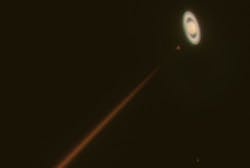Toptica SodiumStar laser installed at ESO's Very Large Telescope (VLT) in Chile
The first sodium-line-wavelength laser unit of the 4 Laser Guide Star Facility (4LGSF) has been installed at Unit Telescope 4 of the European Southern Observatory's (ESO's) Very Large Telescope (VLT) at the Paranal Observatory in Chile. The SodiumStar lasers are produced by Toptica Photonics (Munich, Germany).
Toptica and ESO engineers were able to successfully complete the foreseen set of verification tests, preceding the first light and several on-sky measurements. This is a major step towards the completion of the full Adaptive Optics Facility.
Linewidth of less than 5 MHz
The core of the installed SodiumStar laser system is based on a narrow-band seed diode laser, a fiber-based Raman fiber-amplifier module, and a high-efficiency resonant frequency-conversion unit. Raman fiber amplification occurs due to a nonlinear interaction between a seed laser and a spectrally shifted broadband pump laser within an optical fiber. The amplifier is fed with the light of a DL distributed-feedback (DFB) infrared diode laser and the output is frequency-doubled to achieve a total average output power of more than 20 W at the sodium-line wavelength of 589 nm. The laser light has a linewidth of less than 5 MHz and a 10% repumper frequency sideband at 1.7 GHz.
The laser light excites sodium atoms in the mesosphere, which is located 90 to 110 km above Earth's surface. The re-emitted fluorescence light of the atoms undergoes the same distortions in the atmosphere as the light emitted from real stars further out in the universe. Therefore, the fluorescence light of the sodium atoms can, via the telescope's adaptive optical wavefront sensor and corrector, be used to measure and compensate for the atmospheric turbulence. In this way, diffraction-limited images of real stars can be obtained with the ground-based telescope.
Toptica's SodiumStar laser was developed in collaboration with the Canadian MPB Communications. It is an alternative to power-limited and maintenance-demanding dye lasers or sum-frequency mixing of solid-state lasers that were used to create sodium laser guide stars in the past. The installation of three additional SodiumStar lasers is planned in the near future, which will complete the 4LGSF.
"We are proud and happy to contribute to this major achievement of the 4LGSF ESO program, and to see the technology now broadly adopted also by other major telescopes," said Wilhelm Kaenders, president of Toptica.
Source: Toptica

John Wallace | Senior Technical Editor (1998-2022)
John Wallace was with Laser Focus World for nearly 25 years, retiring in late June 2022. He obtained a bachelor's degree in mechanical engineering and physics at Rutgers University and a master's in optical engineering at the University of Rochester. Before becoming an editor, John worked as an engineer at RCA, Exxon, Eastman Kodak, and GCA Corporation.
